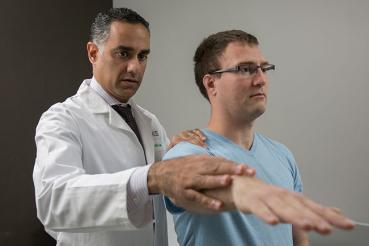Most people think joint problems are limited to serious athletes or older adults. But when it comes to the shoulder, everyone is at risk.
Between the ages of 18 and 88, almost everyone will experience some kind of shoulder issue, according to Gregory Nicholson, MD, an orthopedic surgeon who specializes in shoulder surgery at Rush University Medical Center.
In fact, shoulders are the most commonly injured joints in the body. The unique and complex anatomy of the shoulder makes it the joint with the greatest range of motion but the least stability. Thus, it is more susceptible to strain, repetitive injuries and aging than other joints.
"The shoulder is the only joint that sits on a moveable platform, the shoulder blade," says Nicholson. "There is a link between your chest wall, shoulder blade, arm and the shoulder itself. There is a lot going on there."
Here, Nicholson shares five things you should know about shoulder injuries.
1. Shoulder injuries are highly treatable if addressed early.
"The cornerstone of effectively treating shoulder injuries is early, correct diagnosis," says Nicholson.
Often these injuries can be resolved without surgery. The goals for most shoulder injuries are to decrease inflammation, alleviate pain, strengthen muscles and improve range of motion. The earlier you see a doctor, the more conservative therapies, such as physical therapy and anti-inflammatory medications, can help.
However, people with shoulder pain often avoid seeking prompt medical attention.
"If your shoulder is bothering you, you can fake it for a long time," says Nicholson. "So we tend to see people farther along in their disease process than we do with knee or hip injuries because it doesn't affect their mobility as much."
But ignoring the pain won't make it go away. In fact, the injury will likely continue to worsen and become less amenable to nonsurgical treatments the longer you wait to seek treatment.
2. The problem is often the rotator cuff.
Rotator cuff tears are the most common cause of shoulder pain and disability in adults.
"If you say your shoulder is hurting, someone will probably say, 'It could be your rotator cuff.' Eighty percent of the time, that is right or half right," says Nicholson.
Other common causes of shoulder pain include osteoarthritis, tendinitis, impingement, shoulder instability or a fracture.
The rotator cuff comprises four small muscles and tendons coming off the shoulder blade. Its job is to stabilize the shoulder. Rotator cuff tears can happen suddenly from a fall or accident, or develop over time from repetitive motion and overuse.
A tear weakens the shoulder and makes it difficult or painful to lift your arm overhead, even to do routine things like brushing your hair or getting dressed.
About 50 percent of people with a rotator cuff tear can achieve pain relief and improved shoulder function through nonsurgical treatments, including rest, activity modification, anti-inflammatory medications, physical therapy and steroid injections.
If these treatments don't provide pain relief, doctors often recommend surgery to repair the torn rotator cuff.
3. Disturbed sleep can exacerbate shoulder pain.
While people often delay going to the doctor with shoulder pain, sleep disturbances are often what finally drives them to seek help.
Positioning yourself for sleep can be challenging with shoulder pain, with most sleep positions causing severe discomfort. Further, research has shown that disturbed sleep actually exacerbates pain.
"Patients often come in and say, 'I'm cranky and my personality has changed because I can't get a good night's sleep. I have to do something about this shoulder,' " says Nicholson.
Positioning yourself for sleep can be challenging with shoulder pain, with most sleep positions causing severe discomfort. Further, research has shown that disturbed sleep actually exacerbates pain.
4. Exercise can help — and hurt — your shoulders.
Staying strong and flexible are the best ways to keep your shoulders healthy and prevent injuries. However, it's important to focus on good form; bad exercise techniques can wreak havoc on your shoulders.
"I see people at health clubs all the time doing exercises with their arms straight out, away from their bodies with their elbows straight," says Nicholson. "That looks good and feels like it is working your shoulder muscles. But, if you have a vulnerable shoulder, that form puts tremendous stress and strain across the rotator cuff."
Instead, Nicholson recommends using resistance bands instead of weights and keeping your elbows bent at 90 degrees for shoulder-strengthening workouts.
"We tell patients to imagine that they are upper-cutting someone in the chin while keeping their elbows bent at 90 degrees," he says. "Using resistance bands and keeping your elbows at 90 degrees allows you to exercise your internal and external shoulder rotation for the front and back of the rotator cuff without putting strain on it."
Try some of these shoulder conditioning exercises from the American Academy of Orthopaedic Surgeons.
5. Shoulder joint replacement is safe and effective.
"Total shoulder replacement for osteoarthritis is a wonderful option to relieve pain and restore function," Nicholson says. "The durability is equal to, if not better, than hip and knee replacement."
The key to a good surgical outcome often rests on the experience of your orthopedic surgeon.
"In our practice, we do between 230 and 270 shoulder replacements a year combined; whereas, most shoulder replacements in the U.S. are done by orthopedic surgeons who are good surgeons, but they only do about four shoulder replacements a year," says Nicholson.
"Our experience allows us to have better results and lower complication rates than surgeons who do fewer shoulder replacements each year."




